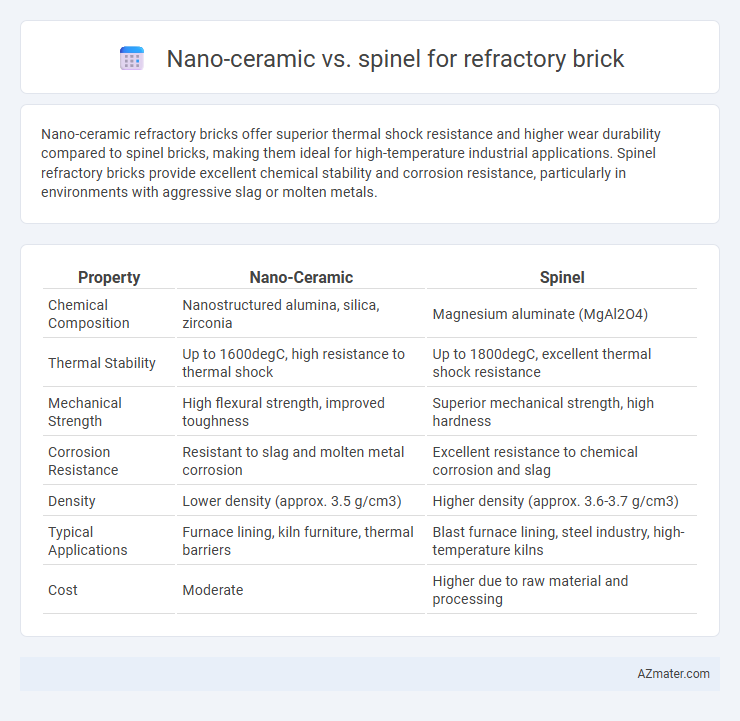Nano-ceramic refractory bricks offer superior thermal shock resistance and higher wear durability compared to spinel bricks, making them ideal for high-temperature industrial applications. Spinel refractory bricks provide excellent chemical stability and corrosion resistance, particularly in environments with aggressive slag or molten metals.
Table of Comparison
| Property | Nano-Ceramic | Spinel |
|---|---|---|
| Chemical Composition | Nanostructured alumina, silica, zirconia | Magnesium aluminate (MgAl2O4) |
| Thermal Stability | Up to 1600degC, high resistance to thermal shock | Up to 1800degC, excellent thermal shock resistance |
| Mechanical Strength | High flexural strength, improved toughness | Superior mechanical strength, high hardness |
| Corrosion Resistance | Resistant to slag and molten metal corrosion | Excellent resistance to chemical corrosion and slag |
| Density | Lower density (approx. 3.5 g/cm3) | Higher density (approx. 3.6-3.7 g/cm3) |
| Typical Applications | Furnace lining, kiln furniture, thermal barriers | Blast furnace lining, steel industry, high-temperature kilns |
| Cost | Moderate | Higher due to raw material and processing |
Introduction to Nano-ceramic and Spinel Refractory Bricks
Nano-ceramic refractory bricks leverage nanotechnology to enhance thermal stability, mechanical strength, and resistance to thermal shock compared to traditional materials. Spinel refractory bricks, composed mainly of magnesium aluminate (MgAl2O4), offer excellent chemical and thermal resistance, making them ideal for high-temperature environments in steelmaking and glass industries. Both materials improve durability and performance in extreme conditions, with nano-ceramics providing finer microstructure control and spinel renowned for its stable crystalline structure.
Key Properties of Nano-ceramic Refractories
Nano-ceramic refractories exhibit exceptional thermal stability, high melting points above 2000degC, and superior resistance to thermal shock compared to spinel-based bricks, which typically operate effectively up to 1800degC. Their nano-scale grain structure enhances mechanical strength and corrosion resistance, enabling prolonged service life in harsh environments such as steel and cement industries. These key properties make nano-ceramic refractories ideal for applications requiring advanced durability and heat retention beyond the capabilities of conventional spinel refractories.
Essential Characteristics of Spinel-Based Refractory Bricks
Spinel-based refractory bricks exhibit exceptional thermal stability, high mechanical strength, and superior corrosion resistance compared to nano-ceramic counterparts. Their chemical composition, primarily magnesium aluminate (MgAl2O4), offers excellent resistance to slag penetration and thermal shock, making them ideal for harsh industrial environments such as steel and cement production. The spinel structure contributes to better load-bearing capacity and longevity under extreme temperatures, outperforming many nano-ceramic variants in refractoriness and durability.
Thermal Stability: Nano-ceramic vs Spinel
Nano-ceramic refractory bricks exhibit superior thermal stability with high resistance to thermal shock and minimal grain growth at elevated temperatures above 1600degC. Spinel refractory bricks provide excellent thermal stability as well, maintaining structural integrity and resistance to slag attack in high-temperature environments up to 1700degC. Comparative analysis shows that while both materials perform well, nano-ceramics offer enhanced microstructural stability and longevity in cyclic thermal applications.
Mechanical Strength Comparison
Nano-ceramic refractory bricks exhibit superior mechanical strength compared to spinel bricks, due to their finer grain size and enhanced densification achieved through advanced sintering techniques. The nano-scale structure of nano-ceramics results in higher hardness, improved fracture toughness, and greater resistance to thermal shock, making them ideal for high-stress industrial applications. Spinel bricks, while offering good chemical stability and moderate mechanical strength, generally fall short in wear resistance and load-bearing capacity relative to nano-ceramic counterparts.
Corrosion and Erosion Resistance
Nano-ceramic refractory bricks exhibit superior corrosion resistance due to their densely packed nanoparticle structure, which limits chemical infiltration and extends service life in aggressive environments. Spinel bricks, composed primarily of magnesium aluminate, offer excellent erosion resistance by maintaining high hardness and thermal stability under high-velocity particulate flow. Combining nano-ceramic technology with spinel composition can enhance both corrosion and erosion resistance, providing optimal performance for refractory applications in harsh industrial processes.
Energy Efficiency and Heat Retention
Nano-ceramic refractory bricks exhibit superior energy efficiency due to their enhanced thermal insulation properties and reduced thermal conductivity compared to Spinel bricks. Spinel refractory materials, while offering excellent mechanical strength and chemical stability, generally have higher heat retention but lower insulation capability, leading to increased energy consumption in high-temperature applications. Leveraging nano-ceramic technology in refractory bricks optimizes heat retention while minimizing heat loss, resulting in significant energy savings and improved furnace performance.
Cost-Effectiveness and Lifespan
Nano-ceramic refractory bricks offer superior thermal shock resistance and longer lifespan compared to spinel bricks, resulting in reduced maintenance and replacement costs over time. Although spinel bricks are generally lower in initial cost, their shorter durability can lead to increased downtime and higher cumulative expenses. Evaluating total cost-effectiveness favors nano-ceramic bricks in high-temperature industrial applications requiring extended service life and reliable performance.
Industrial Applications: Suitability Analysis
Nano-ceramic refractory bricks exhibit superior thermal shock resistance and enhanced mechanical strength, making them ideal for high-temperature industrial applications such as steel and glass manufacturing. Spinel refractory bricks offer excellent chemical stability and resistance to slag corrosion, suitable for environments with aggressive slags in cement and lime kilns. Analyzing industrial suitability shows nano-ceramics excel in thermal cycling conditions, while spinels provide longevity in chemically reactive atmospheres.
Future Trends in Refractory Brick Technology
Nano-ceramic and spinel materials represent key advancements in refractory brick technology, offering enhanced thermal stability and corrosion resistance. Future trends emphasize the integration of nano-engineered ceramics to improve mechanical strength and lifespan, while spinel compositions are being optimized for superior slag resistance in high-temperature industrial applications. Innovations in material synthesis and microstructure control are expected to drive the development of refractory bricks with greater energy efficiency and environmental sustainability.

Infographic: Nano-ceramic vs Spinel for Refractory brick
 azmater.com
azmater.com